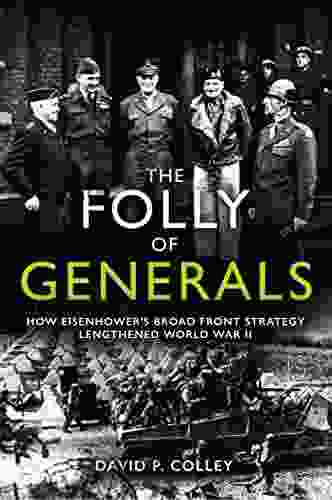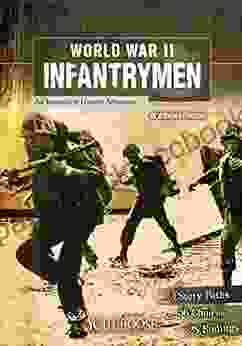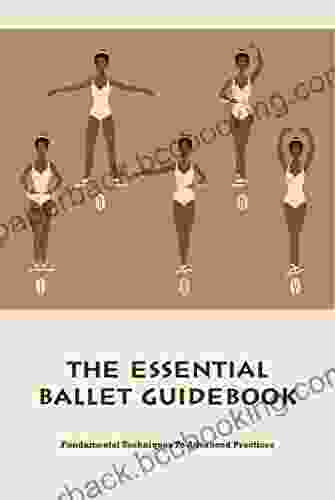How Eisenhower's Broad Front Strategy Lengthened World War II: A Comprehensive Analysis

The Second World War was a global conflict fought between the Allies and the Axis powers, resulting in the deaths of millions and shaping the geopolitical landscape of the 20th century.
4.2 out of 5
| Language | : | English |
| File size | : | 25195 KB |
| Text-to-Speech | : | Enabled |
| Screen Reader | : | Supported |
| Enhanced typesetting | : | Enabled |
| Word Wise | : | Enabled |
| Print length | : | 257 pages |
| Lending | : | Enabled |
One of the key figures in the Allied victory was General Dwight D. Eisenhower, Supreme Allied Commander in Europe. Eisenhower's approach to the war was heavily influenced by the Broad Front Strategy, which aimed to engage the enemy on multiple fronts simultaneously.
The Broad Front Strategy has been a subject of much debate among historians. Some argue that it prolonged the war and resulted in unnecessary casualties. Others contend that it was the only viable strategy to defeat the Axis powers.
The Origins of the Broad Front Strategy
The Broad Front Strategy emerged during the interwar period, when military thinkers sought ways to overcome the bloody stalemates of World War I. The strategy was based on the belief that a simultaneous attack on multiple fronts would prevent the enemy from concentrating their forces.
Eisenhower was a strong advocate of the Broad Front Strategy. He believed that it would allow the Allies to exploit their numerical superiority and overwhelm the Axis powers.
The Broad Front Strategy in Action
The Broad Front Strategy was put into action in Europe in 1944, with the Allied landings in Normandy and Southern France. Eisenhower planned to push the Germans back on all fronts simultaneously, hoping to break their lines and liberate Europe.
The strategy initially met with some success. The Allies made steady progress in Normandy and Southern France, and the Germans were forced to retreat. However, the Broad Front Strategy also had its drawbacks.
The Weaknesses of the Broad Front Strategy
One of the main weaknesses of the Broad Front Strategy was that it required a large number of troops and resources. The Allies had to spread their forces across multiple fronts, which made it difficult to concentrate their strength.
Another weakness was that the Broad Front Strategy made it difficult to exploit breakthroughs. When the Allies did break through German lines, they often lacked the reserves to pursue the enemy and capitalize on their success.
The Alternatives to the Broad Front Strategy
Some historians have argued that there were better alternatives to the Broad Front Strategy. One alternative was the "narrow front" strategy, which involved concentrating Allied forces on a single front and overwhelming the enemy there.
Another alternative was the "indirect" strategy, which involved using deception and maneuver to outflank the enemy and avoid direct confrontations.
The Impact of the Broad Front Strategy on World War II
The Broad Front Strategy had a significant impact on the course of World War II. It is difficult to say definitively whether it prolonged the war or not, but it certainly contributed to the high casualties on both sides.
The strategy did eventually lead to the Allied victory, but it is possible that a different approach could have achieved the same result with less bloodshed.
The Broad Front Strategy is a complex and controversial issue. There are strong arguments both for and against it. Ultimately, it is up to each individual to decide whether they believe it was the best strategy for the Allies to take in World War II.
4.2 out of 5
| Language | : | English |
| File size | : | 25195 KB |
| Text-to-Speech | : | Enabled |
| Screen Reader | : | Supported |
| Enhanced typesetting | : | Enabled |
| Word Wise | : | Enabled |
| Print length | : | 257 pages |
| Lending | : | Enabled |
Do you want to contribute by writing guest posts on this blog?
Please contact us and send us a resume of previous articles that you have written.
 Book
Book Novel
Novel Page
Page Chapter
Chapter Text
Text Story
Story Genre
Genre Reader
Reader Library
Library Paperback
Paperback E-book
E-book Magazine
Magazine Newspaper
Newspaper Paragraph
Paragraph Sentence
Sentence Bookmark
Bookmark Shelf
Shelf Glossary
Glossary Bibliography
Bibliography Foreword
Foreword Preface
Preface Synopsis
Synopsis Annotation
Annotation Footnote
Footnote Manuscript
Manuscript Scroll
Scroll Codex
Codex Tome
Tome Bestseller
Bestseller Classics
Classics Library card
Library card Narrative
Narrative Biography
Biography Autobiography
Autobiography Memoir
Memoir Reference
Reference Encyclopedia
Encyclopedia Tom Humphrey
Tom Humphrey Marilyn Jansen
Marilyn Jansen Lina Chang
Lina Chang Vassos Alexander
Vassos Alexander Vanessa Lapointe
Vanessa Lapointe Stacey Abrams
Stacey Abrams Marcia Langton
Marcia Langton Neal Boortz
Neal Boortz Sally Hogshead
Sally Hogshead Tori Bortman
Tori Bortman Morgan A Wider
Morgan A Wider Shawn P Williams
Shawn P Williams Scott Krig
Scott Krig Stuart Stirling
Stuart Stirling Martha E Casazza
Martha E Casazza Mei Yu
Mei Yu Megan Sloan
Megan Sloan Wendy Doniger
Wendy Doniger Sonja Dewing
Sonja Dewing Learning Through Activities
Learning Through Activities
Light bulbAdvertise smarter! Our strategic ad space ensures maximum exposure. Reserve your spot today!
 Sammy PowellFollow ·16.8k
Sammy PowellFollow ·16.8k Isaiah PowellFollow ·6.4k
Isaiah PowellFollow ·6.4k William FaulknerFollow ·13.6k
William FaulknerFollow ·13.6k Liam WardFollow ·14.3k
Liam WardFollow ·14.3k Jorge AmadoFollow ·16.4k
Jorge AmadoFollow ·16.4k D'Angelo CarterFollow ·16.5k
D'Angelo CarterFollow ·16.5k Jamal BlairFollow ·14k
Jamal BlairFollow ·14k Darnell MitchellFollow ·15k
Darnell MitchellFollow ·15k

 E.M. Forster
E.M. ForsterBluewater Walkabout: Into the Pacific
An Unforgettable...

 Joseph Foster
Joseph FosterUnlock the Secrets of Standardized Test Success with Test...
Are you tired of struggling with standardized...

 Joe Simmons
Joe SimmonsUnlock Learning with Flash Cards for Kindergarten:...
Ignite a Passion for...

 Raymond Parker
Raymond ParkerJourney into the Enchanting World of "The Heart Kingdom"...
A Timeless Tale of Love,...
4.2 out of 5
| Language | : | English |
| File size | : | 25195 KB |
| Text-to-Speech | : | Enabled |
| Screen Reader | : | Supported |
| Enhanced typesetting | : | Enabled |
| Word Wise | : | Enabled |
| Print length | : | 257 pages |
| Lending | : | Enabled |
















